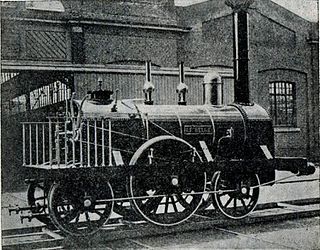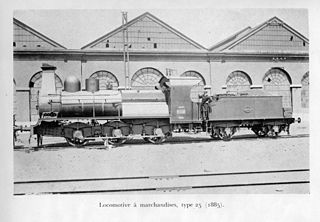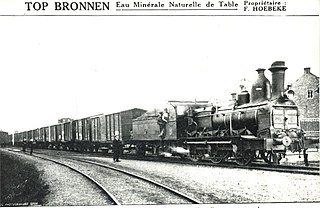| Belgian State Railways Type 5 | |||||||||||||||||||||||||||||
|---|---|---|---|---|---|---|---|---|---|---|---|---|---|---|---|---|---|---|---|---|---|---|---|---|---|---|---|---|---|
| |||||||||||||||||||||||||||||
| |||||||||||||||||||||||||||||
| |||||||||||||||||||||||||||||
The Belgian State Railways Type 5 was a class of 2-4-0 T steam locomotives for local passenger service, introduced in 1880. [1]
| Belgian State Railways Type 5 | |||||||||||||||||||||||||||||
|---|---|---|---|---|---|---|---|---|---|---|---|---|---|---|---|---|---|---|---|---|---|---|---|---|---|---|---|---|---|
| |||||||||||||||||||||||||||||
| |||||||||||||||||||||||||||||
| |||||||||||||||||||||||||||||
The Belgian State Railways Type 5 was a class of 2-4-0 T steam locomotives for local passenger service, introduced in 1880. [1]
The locomotives were built by various manufacturers from 1880 to 1881. [1] The machines had an outside frame with the cylinders and the Walschaert located inside the frame. [2] Starting with 1900 the machines received new boilers, with overall weight increasing to 32 t (31.49 long tons; 35.27 short tons). [1]
| Manufacturer | Serial Numbers | Quantity | Date in service | État Belge Numbers |
|---|---|---|---|---|
| Franco-Belge [4] | 326–335 | 10 | 1881 | EB 1220–1224, 1278–1282 |
| Franco-Belge [4] | 340–341, 343, 342, 339, 344–345, 349–350, 355, 351 | 11 | 1881 | EB 1357–1367 |
| Saint-Léonard [5] [6] | 552–558 | 7 | 1881 | EB 227, 229, 536, 564, 862, 971, 1425 |
| Franco-Belge [4] | 354, 353, 356, 358, 357, 360, 359, 361 | 8 | 1881 | EB 1426–1433 |
| Zimmermann-Hanrez [7] | 76 | 1 | 1900 | EB 1218 (Type 5bis, possibly a rebuild) [7] |

Belgium was heavily involved in the early development of railway transport. Belgium was the second country in Europe, after Great Britain, to open a railway and produce locomotives. The first line, between the cities of Brussels and Mechelen opened in 1835. Belgium was the first state in Europe to create a national railway network and the first to possess a nationalised railway system. The network expanded fast as Belgium industrialised, and by the early 20th century was increasingly under state-control. The nationalised railways, under the umbrella organisation National Railway Company of Belgium (NMBS/SNCB), retained their monopoly until liberalisation in the 2000s.

The NMBS/SNCB Type 12 was a class of 4-4-2 steam locomotives built in 1938–1939 for the fast lightweight Ostend boat trains operated by the National Railway Company of Belgium.

The Mayumbe line was a 140 km (87 mi) long 610 mm gauge narrow gauge railway in the north west of the Democratic Republic of the Congo between the port of Boma and Tshela.

The Belgian State Railways Type 23, later known as the NMBS/SNCB Type 53, was a class of 0-8-0T steam locomotives built between 1904 and 1927.

SNCF 150.P were a class of 2-10-0 “Decapod” steam locomotives built as standard locomotives of the newly created Société Nationale des Chemins de fer Français (SNCF) between April 1940 and April 1950

The NMBS/SNCB Type 64 was a class of 4-6-0 steam locomotives built as Prussian P 8s for German railways, delivered as war reparations to Belgium at the end of World War I. 168 locomotives of this type were delivered to Belgium, working mostly on light passenger trains operated by the National Railway Company of Belgium (NMBS/SNCB). The final locomotives of this type were withdrawn in 1967, marking the end of steam service in the country.

The Belgian State Railways Type 1 was a class of 2-4-0 steam locomotives for passenger service, introduced in 1864.

The Belgian State Railways Type 12 was a class of 2-4-2 steam locomotives for express passenger service, introduced in 1888. They were the successors of the Belgian State Railways Type 1 locomotives.

The Belgian State Railways Type 25 was a class of 0-6-0 steam locomotives for freight service, introduced in 1884.

The Belgian State Railways Type 28 was a class of 0-6-0 steam locomotives for freight service, introduced in 1864.
The Belgian State Railways Type 29 was a class of 0-6-0 steam locomotives for freight service, introduced in 1875.
The Belgian State Railways Type 2 was a class of 0-6-0 steam locomotives for passenger service, introduced in 1875. Alfred Belpaire derived the locomotive design from the Type 28 by replacing the 1,450 mm (57.09 in) wheels of the Type 28 with larger 1,700 mm (66.93 in) diameter ones.

The Belgian State Railways Type 51 was a class of 0-6-0T steam locomotives for shunting and local train service, introduced in 1866.
The Belgian State Railways Type 20 was a class of 0-8-0T steam locomotives, introduced in 1870.
The Belgian State Railways Type 11 was a class of 0-6-0T steam locomotives for local passenger traffic, introduced in 1888. It gradually replaced the Type 5 in this role.
The Belgian State Railways Type 6 was a class of 2-6-0 steam locomotives for express passenger service, introduced in 1885.
The Belgian State Railways Type 4 was a class of 2-6-2T steam locomotives for passenger traffic, introduced in 1878.

The Belgian State Railways Type 30 was a class of 0-6-0 steam locomotives for mixed service, introduced in 1900.

The Belgian State Railways Type 32 was a class of 0-6-0 steam locomotives for mixed service, introduced in 1902.
Ateliers de construction de La Meuse are a manufacturing and engineering company based in Liège in Belgium. During the period from 1888 to 1958, La Meuse built 1350 steam locomotives some for Belgian State Railways, and many more for industrial networks. Of these a substantial number survive worldwide.
| Wikimedia Commons has media related to Belgian State Railways Type 5 . |